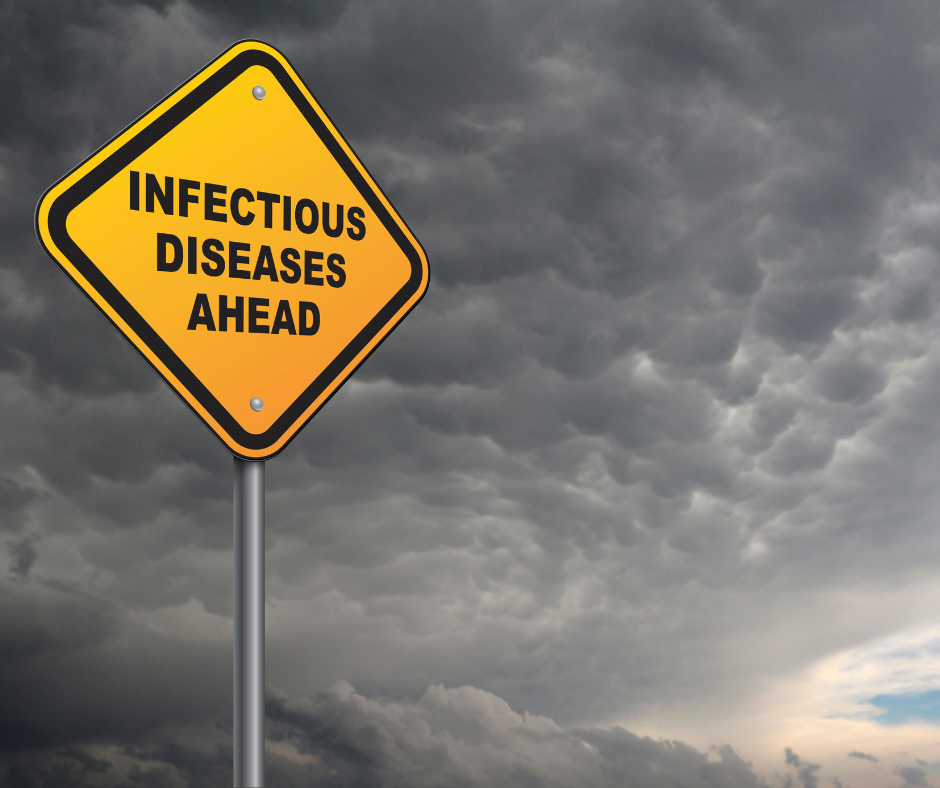
Wildlife can spread rabies (as well as equine protozoal myeloencephalitis (EPM) to horses), so secure your farm against unwanted visitors. Controlling infectious diseases relies on understanding how they spread. Infectious organisms are transmitted through the following routes:
Aerosols
Respiratory droplets from sick animals become airborne through coughing, snorting, or sneezing. Residue from evaporated droplets and infected dust particles can also become suspended in the air. Infectious organisms are transferred when they contact the eyes, nose, or mouth. Pathogens vary in their ability to survive and transmissibility in the air, which are impacted by environmental factors including wind, humidity, and temperature. Airborne diseases are challenging to contain and can spread quickly. To reduce the rate of transmission, keep distance between animals, keep dust down, and ensure proper ventilation in enclosed spaces.
Direct Contact
Some diseases spread through close physical contact with infected animals, their body fluids or tissues, and direct touching of wounds, skin, or mucous membranes around the nose, eyes, and mouth. Affected animals can infect other animals through nose-to-nose contact or biting. Limit contact between stalls and in aisle ways and clean and disinfect water troughs regularly to reduce direct contact.
Indirect Contact
Objects contaminated with infectious organisms are called fomites. These can include tack, buckets, grooming supplies, hoses, clothing, and vehicles. Avoid sharing equipment between animals. If equipment must be shared, clean and disinfect it between uses. Dedicate separate supplies and equipment for sick animals. Keep vehicles and trailers in designated areas. Limit traffic, people, and other animals in areas to minimize spread through indirect contact.
Oral
Livestock can consume pathogens in feed or water contaminated by feces or urine from infected animals. Licking or chewing contaminated objects in the environment can also lead to ingestion of pathogens. Diseases spread through oral transmission include salmonellosis and equine coronavirus. Control feed sources, ensure feed quality, and handle and store feed properly. Clean stalls regularly, manage fecal piles in fields and barnyards, and ensure proper waste management. Avoid natural water sources such as streams that might be contaminated with feces or urine from wildlife and livestock.
Vectors
Insects, such as mosquitoes and flies, or ticks can transmit infectious organisms between animals. Proper vector control is an essential part of any biosecurity plan. Use insecticide applications as appropriate. Fence off areas with high insect and tick populations. Eliminate insect breeding areas, including standing water and decaying organic matter.
Wildlife
Rodents, skunks, opossums, bats, birds, and other wildlife can also act as disease vectors. Diseases spread by wildlife include rabies as well as equine protozoal myeloencephalitis (EPM). Prevent wildlife from accessing barn areas, sweep regularly, keep barns tidy, and clean up and store feed in containers with securable lids. Patch holes and gaps in buildings to prevent wildlife access. Do not leave pet food or water out overnight, and keep compost piles away from barns.
Information gathered from UC Davis School of Veterinary Medicine.